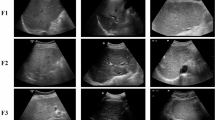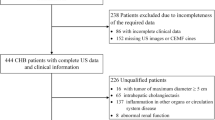Abstract
Objectives
The aim of this study was to develop a deep convolutional neural network (DCNN) for the prediction of the METAVIR score using B-mode ultrasonography images.
Methods
Datasets from two tertiary academic referral centers were used. A total of 13,608 ultrasonography images from 3446 patients who underwent surgical resection, biopsy, or transient elastography were used for training a DCNN for the prediction of the METAVIR score. Pathological specimens or estimated METAVIR scores derived from transient elastography were used as a reference standard. A four-class model (F0 vs. F1 vs. F23 vs. F4) was developed. Diagnostic performance of the algorithm was validated on a separate internal test set of 266 patients with 300 images and external test set of 572 patients with 1232 images. Performance in classification of cirrhosis was compared between the DCNN and five radiologists.
Results
The accuracy of the four-class model was 83.5% and 76.4% on the internal and external test set, respectively. The area under the receiver operating characteristic curve (AUC) for classification of cirrhosis (F4) was 0.901 (95% confidence interval [CI], 0.865–0.937) on the internal test set and 0.857 (95% CI, 0.825–0.889) on the external test set, respectively. The AUC of the DCNN for classification of cirrhosis (0.857) was significantly higher than that of all five radiologists (AUC range, 0.656–0.816; p value < 0.05) using the external test set.
Conclusions
The DCNN showed high accuracy for determining METAVIR score using ultrasonography images and achieved better performance than that of radiologists in the diagnosis of cirrhosis.
Key Points
• DCNN accurately classified the ultrasonography images according to the METAVIR score.
• The AUROC of this algorithm for cirrhosis assessment was significantly higher than that of radiologists.
• DCNN using US images may offer an alternative tool for monitoring liver fibrosis.





Similar content being viewed by others
Abbreviations
- AUC:
-
Area under the receiver operating characteristic curve
- CI:
-
Confidence interval
- CLD:
-
Chronic liver disease
- CT:
-
Computed tomography
- DCNN:
-
Deep convolutional neural network
- DICOM:
-
Digital Imaging and Communications in Medicine
- MR:
-
Magnetic resonance
- SMC:
-
Samsung Medical Center
- SNUH:
-
Seoul National University Hospital
- TE:
-
Transient elastography
- US:
-
Ultrasonography
References
GBD 2013 Mortality and Causes of Death Collaborators (2015) Global, regional, and national age-sex specific all-cause and cause-specific mortality for 240 causes of death, 1990-2013: a systematic analysis for the Global Burden of Disease Study 2013. Lancet 385:117–171
Manning DS, Afdhal NH (2008) Diagnosis and quantitation of fibrosis. Gastroenterology 134:1670–1681
Vergniol J, Foucher J, Terrebonne E et al (2011) Noninvasive tests for fibrosis and liver stiffness predict 5-year outcomes of patients with chronic hepatitis C. Gastroenterology 140:1970–1979 1979 e1971–1973
Seeff LB, Everson GT, Morgan TR et al (2010) Complication rate of percutaneous liver biopsies among persons with advanced chronic liver disease in the HALT-C trial. Clin Gastroenterol Hepatol 8:877–883
Stotland BR, Lichtenstein GR (1996) Liver biopsy complications and routine ultrasound. Am J Gastroenterol 91:1295–1296
Guido M, Rugge M (2004) Liver biopsy sampling in chronic viral hepatitis. Semin Liver Dis 24:89–97
European Association for Study of Liver; Asociacion Latinoamericana para el Estudio del Higado (2015) EASL-ALEH clinical practice guidelines: non-invasive tests for evaluation of liver disease severity and prognosis. J Hepatol 63:237–264
Dietrich CF, Bamber J, Berzigotti A et al (2017) EFSUMB guidelines and recommendations on the clinical use of liver ultrasound elastography, update 2017 (long version). Ultraschall Med 38:e48
Ravaioli F, Montagnani M, Lisotti A, Festi D, Mazzella G, Azzaroli F (2018) Noninvasive assessment of portal hypertension in advanced chronic liver disease: an update. Gastroenterol Res Pract 2018:4202091
Cainelli F (2012) Liver diseases in developing countries. World J Hepatol 4:66–67
Tsochatzis EA, Bosch J, Burroughs AK (2014) Liver cirrhosis. Lancet 383:1749–1761
Choi KJ, Jang JK, Lee SS et al (2018) Development and validation of a deep learning system for staging liver fibrosis by using contrast agent-enhanced CT images in the liver. Radiology 289:688–697
Yasaka K, Akai H, Kunimatsu A, Abe O, Kiryu S (2018) Deep learning for staging liver fibrosis on CT: a pilot study. Eur Radiol 28:4578–4585
Yasaka K, Akai H, Kunimatsu A, Abe O, Kiryu S (2018) Liver fibrosis: deep convolutional neural network for staging by using gadoxetic acid-enhanced hepatobiliary phase MR images. Radiology 287:146–155
Forner A, Reig M, Bruix J (2018) Hepatocellular carcinoma. Lancet 391:1301–1314
Tang A, Cloutier G, Szeverenyi NM, Sirlin CB (2015) Ultrasound elastography and MR elastography for assessing liver fibrosis: part 2, diagnostic performance, confounders, and future directions. AJR Am J Roentgenol 205:33–40
Castéra L, Vergniol J, Foucher J et al (2005) Prospective comparison of transient elastography, fibrotest, APRI, and liver biopsy for the assessment of fibrosis in chronic hepatitis C. Gastroenterology 128:343–350
Rousselet MC, Michalak S, Dupré F et al (2005) Sources of variability in histological scoring of chronic viral hepatitis. Hepatology 41:257–264
Cardoso AC, Carvalho-Filho RJ, Stern C et al (2012) Direct comparison of diagnostic performance of transient elastography in patients with chronic hepatitis B and chronic hepatitis C. Liver Int 32:612–621
Singh S, Muir AJ, Dieterich DT, Falck-Ytter YT (2017) American Gastroenterological Association Institute technical review on the role of elastography in chronic liver diseases. Gastroenterology 152:1544–1577
Simonyan K, Vedaldi A, Zisserman A (2014) Deep inside convolutional networks: visualising image classification models and saliency maps. arXiv:1312.6034
LeCun Y, Bengio Y, Hinton G (2015) Deep learning. Nature 521:436–444
Yeom SK, Lee CH, Cha SH, Park CM (2015) Prediction of liver cirrhosis, using diagnostic imaging tools. World J Hepatol 7:2069–2079
Huber A, Ebner L, Heverhagen JT, Christe A (2015) State-of-the-art imaging of liver fibrosis and cirrhosis: a comprehensive review of current applications and future perspectives. Eur J Radiol Open 2:90–100
Lim JK, Flamm SL, Singh S, Falck-Ytter YT, Clinical Guidelines Committee of the American Gastroenterological Association (2017) American Gastroenterological Association Institute guideline on the role of elastography in the evaluation of liver fibrosis. Gastroenterology 152:1536–1543
Lee JG, Jun S, Cho YW et al (2017) Deep learning in medical imaging: general overview. Korean J Radiol 18:570–584
Esteva A, Kuprel B, Novoa RA et al (2017) Dermatologist-level classification of skin cancer with deep neural networks. Nature 542:115–118
Lakhani P, Sundaram B (2017) Deep learning at chest radiography: automated classification of pulmonary tuberculosis by using convolutional neural networks. Radiology 284:574–582
Ting DSW, Cheung CY, Lim G et al (2017) Development and validation of a deep learning system for diabetic retinopathy and related eye diseases using retinal images from multiethnic populations with diabetes. JAMA 318:2211–2223
Hu P, Wu F, Peng J, Liang P, Kong D (2016) Automatic 3D liver segmentation based on deep learning and globally optimized surface evolution. Phys Med Biol 61:8676–8698
Hamm CA, Wang CJ, Savic LJ et al (2019) Deep learning for liver tumor diagnosis part I: development of a convolutional neural network classifier for multi-phasic MRI. Eur Radiol 29:3338–3347
Vigano M, Visentin S, Aghemo A, Rumi MG, Ronchi G (2005) US features of liver surface nodularity as a predictor of severe fibrosis in chronic hepatitis C. Radiology 234:641 author reply 641
Lee CH, Choi JW, Kim KA, Seo TS, Lee JM, Park CM (2006) Usefulness of standard deviation on the histogram of ultrasound as a quantitative value for hepatic parenchymal echo texture; preliminary study. Ultrasound Med Biol 32:1817–1826
Colli A, Fraquelli M, Andreoletti M, Marino B, Zuccoli E, Conte D (2003) Severe liver fibrosis or cirrhosis: accuracy of US for detection--analysis of 300 cases. Radiology 227:89–94
Soresi M, Giannitrapani L, Cervello M, Licata A, Montalto G (2014) Non invasive tools for the diagnosis of liver cirrhosis. World J Gastroenterol 20:18131–18150
Berzigotti A, Abraldes JG, Tandon P et al (2010) Ultrasonographic evaluation of liver surface and transient elastography in clinically doubtful cirrhosis. J Hepatol 52:846–853
Li R, Hua X, Guo Y, Zhang P, Guo A (2006) Neighborhood-pixels algorithm combined with Sono-CT in the diagnosis of cirrhosis: an experimental study. Ultrasound Med Biol 32:1515–1520
Castelvecchi D (2016) Can we open the black box of AI? Nature 538:20–23
Park SH, Han K (2018) Methodologic guide for evaluating clinical performance and effect of artificial intelligence technology for medical diagnosis and prediction. Radiology 286:800–809
Funding
This work was financially supported by the Samsung Medical Center (Grant #PHO0132251) and technical support was provided by Samsung Medison and Samsung Electronics (Seoul, Republic of Korea).
Author information
Authors and Affiliations
Corresponding author
Ethics declarations
Guarantor
The scientific guarantor of this publication is Won Jae Lee.
Conflict of interest
Won-Chul Bang, Jonghyun Yi, Gunwoo Lee, and Choonghwan Choi received support in the form of salaries from Samsung Electronics. All other authors declare that they have no conflicts of interest.
Statistics and biometry
One (Kyunga Kim) of the authors has significant statistical expertise.
Informed consent
Written informed consent was waived by the Institutional Review Board.
Ethical approval
Institutional Review Board approval was obtained.
Methodology
• retrospective
• diagnostic or prognostic study
• multicenter study
Additional information
Publisher’s note
Springer Nature remains neutral with regard to jurisdictional claims in published maps and institutional affiliations.
Electronic supplementary material
ESM 1
(DOCX 5453 kb)
Rights and permissions
About this article
Cite this article
Lee, J.H., Joo, I., Kang, T.W. et al. Deep learning with ultrasonography: automated classification of liver fibrosis using a deep convolutional neural network. Eur Radiol 30, 1264–1273 (2020). https://doi.org/10.1007/s00330-019-06407-1
Received:
Revised:
Accepted:
Published:
Issue Date:
DOI: https://doi.org/10.1007/s00330-019-06407-1




